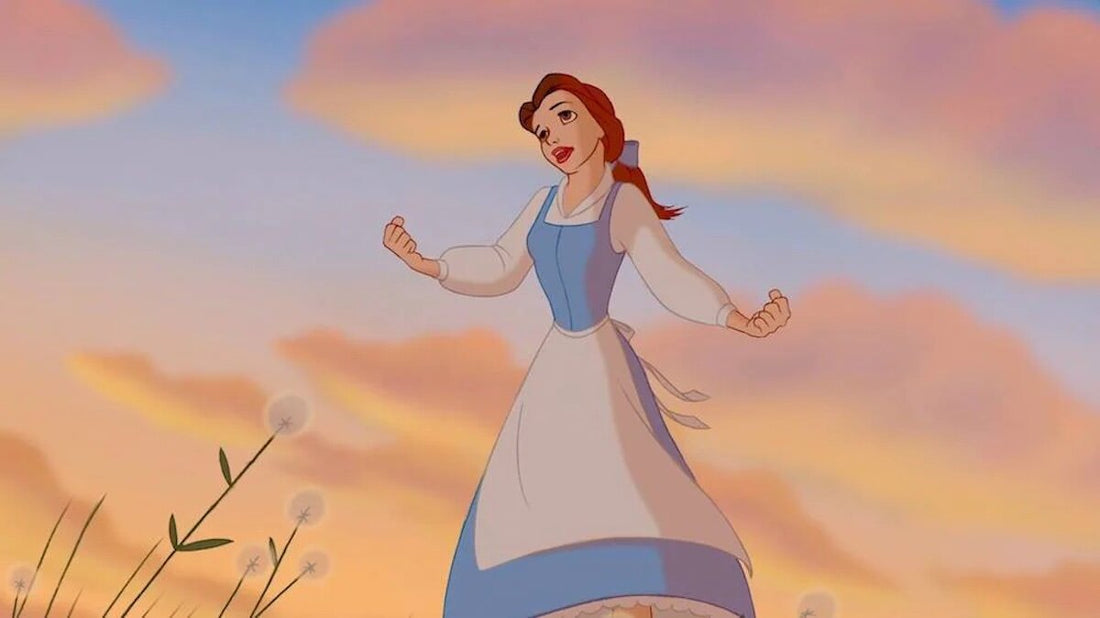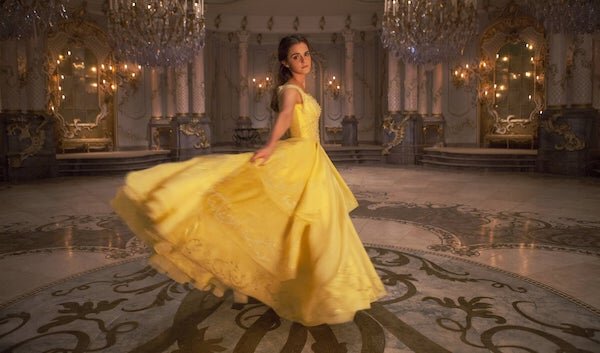While Disney’s animated take on Beauty and the Beast turns 30 years old in 2021, the history of Belle goes much further than the unmistakable yellow gown the cartoon made worldwide. Exploring the legacy of an ambitious, thoughtful, if also imperfect and contradictory princess to aspire to, Lillian Crawford looks back on this funny girl.
The first movie I ever saw was Snow White and the Seven Dwarfs. I remember unwrapping the VHS copy on Christmas morning, popping it in the VCR, and watching the animation come to life. I was hooked – not just on what happened in the films, but on how they are screened: when my parents first took me to the cinema, to see Monsters Inc. aged three, I exclaimed that they must have a really big tape for such a huge screen. I was born in 1998 at the end of the Disney Renaissance, and the beginning of Pixar’s golden age. It’s no wonder I wanted to grow up to be a princess.
But Snow White was hardly an ideal role model for a little girl. She was sheltered to the point of imprisonment, dreaming only that someday her prince would come. When she finally goes out into the world, the princess is immediately redomesticated by a gang of no less than seven men, who fetishise her fairest beauty until another guy comes along and non-consensually kisses her as she sleeps. Then, they ride off into the sunset to get married and live happily ever after.
Looking at the classic Disney princess movies of the 1950s, they seem anti-feminist. My childhood favourites follow the same structure – Cinderella is locked away in domestic servitude then falls in love with the first man she meets, as does Aurora when she’s taken to the woods as Briar Rose in Sleeping Beauty. This narrative, repeatedly told, assures little girls it’s a path they should desire, even if I only sat admiring all the pretty blue and pink ball gowns instead.
The gender imbalance of animators at Walt Disney Studios explains this impression. Female visual artists were mostly relegated to the Ink and Paint department, which filled in the more tedious and fiddly parts of the frame – all those floating bubbles and dancing flowers. Nathalia Holt’s 2019 book The Queens of Animation looks at six women in the story department on films from Pinocchio to Cinderella, to show how male animators often tried to exclude their work, even on the designs of heroines.
Walt Disney could be frighteningly controlling – the actress who voiced Snow White, Adriana Caselotti, had her own voice trademarked and banned from being recorded as it would “spoil the illusion”. She wasn’t named in the film’s credits, and was not acknowledged by the studio as a Disney Legend until 1994. It’s no wonder, then, that the fairytale La belle et la bête captured his imagination. The original story, written in 1740 by Gabrielle-Suzanne Barbot de Villeneuve, has its heroine bullied into housework by her five older sisters, like Cinderella, before she is handed over by her father to the Beast as his fiancée. Another dark tale of a woman without agency, passed between men as an object.
What struck me when I first saw Beauty and the Beast at the age of four was that Belle reads books. All of the other Disney princesses I’d seen spent their time doing housework interspersed with sung daydreams. They weren’t stupid, but their knowledge came through their intuition and hard-knock lives. Belle’s voracious appetite for literature made me realise girls could be scholarly and feminine – that you could get equally as excited about a gorgeous library as a golden dress. It’s still important to me today that there isn’t a contradiction between being an independent feminist and being interested in beauty: they often compliment each other.
Of course, it’s not always that simple. One of the other films I loved as a kid was Barbie in the Nutcracker (for all I knew, Mattel Studios had the same rendering software as Pixar). I’d watch it with my best friend on repeat – me dressed as Cinderella, she as Snow White – and then we’d re-enact the wooden choreography with our toys. The only Belle doll you could buy at the Disney Store was dressed in the elaborate gown worn during the ballroom sequence at the film’s apex – hardly practical for ballet.
I’d have preferred Belle’s blue day dress and matching ribbon to keep her hair out of her eyes, as she reads and walks through the provincial village in the opening number – even if she does navigate the cobbles in ballet slippers (which perhaps explains my penchant for impractical footwear.) But it’s an outfit never seen in Disney’s posters and products. Belle is only presented in her elegant princess persona.
It’s a version of the character Emma Watson wanted to leave behind in the 2017 live-action Beauty and the Beast, insisting Belle wears boots in the village. Watson also ditched the whittled corset for the central dance scene to the film’s title song, refusing to replicate the impossible waistline costume designer Sandy Powell gave Lily James for 2015’s retelling of Cinderella. She couldn’t persuade Disney to change the gown for something more reflective of Belle’s bookish personality though – how else could they sell the film to a young female audience?
The misalignment between how Belle is written and how she is shown was central to the production process of the animated version of Beauty and the Beast in 1991. After the success of The Little Mermaid in 1989, Disney chief Jeffrey Katzenberg wanted the next princess film to have a “feminist twist” to contrast the characterisation of Ariel as a woman obsessed with her pursuit of Prince Eric. His supposedly radical solution two years later, then, was to invite an actual woman to write the screenplay, Linda Woolverton. Supported by lyricist Howard Ashman, Belle’s dialogue is more proactive than previous heroines, wanting “much more than this provincial life” and rejecting beefcake Gaston for only desiring her as his “little wife”. Instead, she would fall in love with Prince Adam’s kind and intelligent personality, before his luscious looks are revealed at the end of the film.
Woolverton never watched Jean Cocteau’s 1946 French film version La Belle et La Bête, which is more inspired by the ancient Roman fairytale ‘Cupid and Psyche’ from Apuleius’ The Golden Ass than Barbot de Villeneuve’s fairytale. In the story, Psyche awakens on a hilltop to find that “a palace had been built, not by human hands but by a divine craftsman” where she is controlled by the invisible voice of Cupid. In both versions, Belle is a prisoner, while Woolverton wanted her to go to the castle voluntarily to take her father’s place once he has been captured by the Beast. As servant-cum-candelabra Lumiere says, “She’s not a prisoner, she’s our guest.”
Instead of Cocteau’s film, Woolverton took inspiration from Jo March in Louisa May Alcott’s Little Women, specifically Katharine Hepburn’s performance in the 1933 film adaptation. Like Belle, Jo dismisses marriage in favour of becoming a writer but ultimately finds that a woman can have both. Unlike Jo, whose hair is her “one beauty”, the character designers for Belle created an amalgamation of impossibly beautiful Hollywood stars; a cross between Audrey Hepburn and Vivien Leigh. Her elegance was modelled on ballerinas painted by Edgar Degas, although she was also given a small imperfection inspired by voice actor Paige O’Hara – a strand of hair occasionally falling out of place.
The film’s insistence that Belle “be our guest” isn’t enough to avoid her romance with Prince Adam being symptomatic of Stockholm syndrome though, wherein a hostage develops a bond with their abuser. Perhaps this would have been avoided had Woolverton been given creative control over the finished film, often having her script changed by the animators in Disney’s story department. She has repeatedly shared anecdotes about her battles with the male animators, such as over a scene she wrote in which Belle points out places she wants to visit on a map, which the other animators wanted to change to a scene in which she bakes a cake for her father.
In retrospect, Belle isn’t the idol for little girls I grew up believing in. Her voracity for literature and ambitions to travel, which Woolverton tirelessly fought for, continue to resonate for girls who want to grow up to be more than wives and mothers, but the Disney animators buried this personality too deeply. Nonetheless, Belle’s fierce independence set a precedent for better-developed heroines in Disney animated movies, seen through the proactivity and strength of Mulan and Pocahontas in their self-titled films, and of Tiana in The Princess and the Frog.
Practical dress has continued to be a problem – to the point that Elsa and Anna wearing trousers in Frozen II was deemed worthy of a news headline almost 30 years after Beauty and the Beast was released. Belle has since reappeared in a number of home release sequels, often reprising the golden number she wears in the iconic ballroom scene with Prince Adam. She wore that dress again in 2018’s Ralph Breaks the Internet, although another scene swapped the gown for pale yellow loungewear – a doll was even released in the ‘Comfy Squad’ princess range with her wearing red glasses and a t-shirt reading ‘Geek Chic’. It’s a version of the character I’d have identified with more as a child, proud to be a funny girl like Belle.
Lillian Crawford (@lillcrawf) is a writer on all things film, culture and gender. Her musings can be found at Little White Lies, Letterboxd and Varsity.




